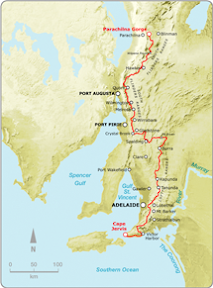Following Never Never Creek
Bundaleer Reservoir to Curnows Hut
Northern Guidebook Maps 1.2-1.4 The map doesn't make it look that exciting, frankly. The Heysen Trail just follows the creek, forming a straightish overall line on the map. I was surprised though, there were a four distinct sections - each quite interesting. Firstly following one of the Bundaleer channels away from Bundaleer Reservoir, to a weir - with flowing water.
The map doesn't make it look that exciting, frankly. The Heysen Trail just follows the creek, forming a straightish overall line on the map. I was surprised though, there were a four distinct sections - each quite interesting. Firstly following one of the Bundaleer channels away from Bundaleer Reservoir, to a weir - with flowing water.

Secondly, there was the creek section, following a valley and fairly dry, the first half containing lots of thriving yacca plants, the second half was distinctly drier, and the hillsides full of dead yacca plants, a bit eerie.  Thirdly, this dry valley turned into an oasis with introduced trees and farms. It was quite a contrast, quite a sudden change too.
Thirdly, this dry valley turned into an oasis with introduced trees and farms. It was quite a contrast, quite a sudden change too.
Fourthly the trail passed down an old road past some extensive and remarkably well surviving ruins of a farm. There was a cottage, and numerous sheds. They appeared to have been abandoned only within the last 30-40 years, perhaps sooner. There was no electricity connected, but plenty of old furniture and old rubbish around, not to mention the thatched roofs. Later in the day I noticed there were many old homes around Bundaleer, and some new homes - but nothing in between, which kinda indicated in the early years it was a thriving place, but almost everything was abandoned 30-40 years ago, with people only returning in the last 10-20 years, building new homes. This was a catch-up walk, an End-to-End 2 walk I missed while in Thailand. I camped at Curnows Hut, a beautiful spot in amongst a pine forest. The hut dates from the 1870's and was the home of the first nurseryman at the historic Bundaleer Forest.
This was a catch-up walk, an End-to-End 2 walk I missed while in Thailand. I camped at Curnows Hut, a beautiful spot in amongst a pine forest. The hut dates from the 1870's and was the home of the first nurseryman at the historic Bundaleer Forest.
Bundaleer Forest was the first plantation forest in South Australia, and also the "birthplace of forestry in Australia". There was early concern that the State's precious native forest cover, never abundant, would be lost forever in the rush to find building materials. From 1873 the South Australian Parliament passed various acts to encourage the planting of forest trees, and in 1876 'Plantation A' - the first forest - was planted at Bundaleer. Many tree species - natives and exotics - were planted to see which would thrive in local conditions, and be commercially useful. Many of these trees, now a century and a quarter old, can still be seen at Bundaleer. The most successful product was the Radiata pine, today widely used in construction. There are other plantations along the Heysen Trail, at Kuitpo Forest and Mt Crawford Forest, but the vast majority of plantations of Pinus Radiatus are in the State's South-East. The first nurseryman at Bundaleer was John Curnow, whose cottage, known as Curnows Hut, is located near the original nursery. The timber from this plantation was used to build Spencer Gulf jetties, railway sleepers and in Broken Hill’s mines.
 I rode the Mawson Trail from the hut, south-eastwards to the main bitumen road, then following some dirt roads back down to Bundaleer Reservoir - the ending place of the last End-to-End walk of last year. Well, almost, I got within a kilometre. I couldn't be bothered riding down there to hike back. Rode a couple of kilometres along the Heysen Trail to an aquaduct - part of one of the Bundaleer channels (see the Marble Hill Road to Bundaleer Reservoir walk). The ride was 23km, and mostly good roads so achieved it in about 2 hours. Left my bike there at the aquaduct, hiking northwards back to Curnows Hut. The hike was approx 16.5km and took 4 hours. After a little sleep in my hammock - conveniently tied between two pine trees - I returned with my car to pick up the bike.
I rode the Mawson Trail from the hut, south-eastwards to the main bitumen road, then following some dirt roads back down to Bundaleer Reservoir - the ending place of the last End-to-End walk of last year. Well, almost, I got within a kilometre. I couldn't be bothered riding down there to hike back. Rode a couple of kilometres along the Heysen Trail to an aquaduct - part of one of the Bundaleer channels (see the Marble Hill Road to Bundaleer Reservoir walk). The ride was 23km, and mostly good roads so achieved it in about 2 hours. Left my bike there at the aquaduct, hiking northwards back to Curnows Hut. The hike was approx 16.5km and took 4 hours. After a little sleep in my hammock - conveniently tied between two pine trees - I returned with my car to pick up the bike.

No comments:
Post a Comment